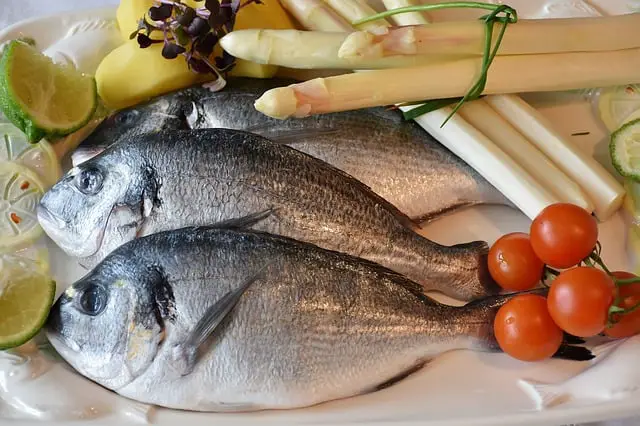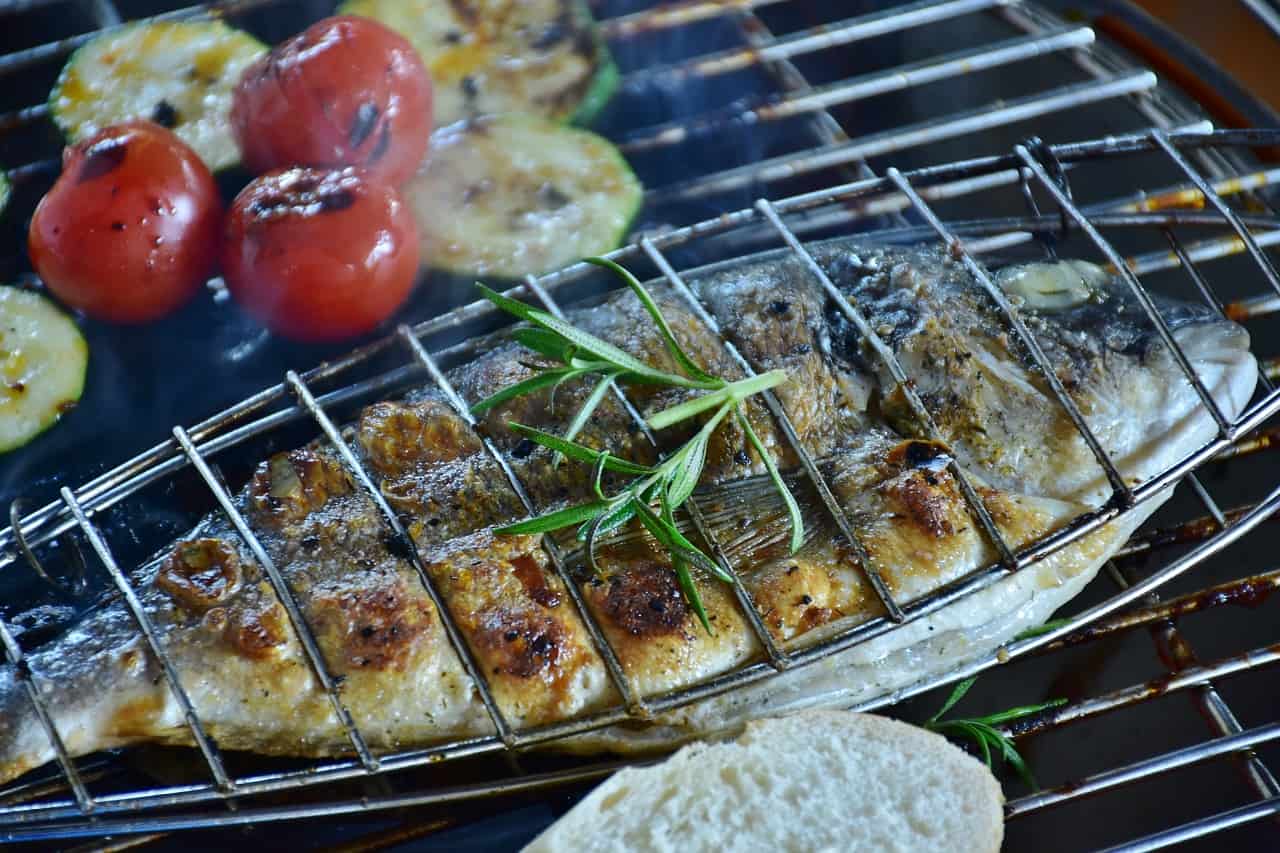Table of Contents
Knowing how to cook fish is an essential cooking skill, like being able to make a pot of rice. Fish is one of the most versatile dishes you can prepare, with so many different kinds of fish to choose from and so many unique and delicious ways to prepare it.
*This post may contain affiliate links. As an Amazon Associate we earn from qualifying purchases.
Not to mention that fish is a healthy and delicious source of protein and fatty acids. Many beginners are intimidated by the idea of filleting, preparing, and cooking fish, but with some basic tips, you’ll be a pro in no time.
Tips on How to Cook Fish
Cooking something new is always a bit daunting, but fish is somehow even more intimidating. Part of this is because there is nothing quite like fish. It isn’t similar to other dishes you’ve prepared.
Fish smells different, tastes different, and while you can use familiar techniques when cooking fish, it really is a whole other game. So, let’s start at the very beginning.
Image via Pixabay
Find the Right Fish
You’ve probably heard the old adage that your dish is only as good as your ingredients. And when you’re cooking fish, this is doubly true. For the very best fish, try shopping at a reputable fish market.
If your city doesn’t have that, try a grocery that has good quality fresh meats. You want to pick the most sustainable option that you can find. Some of those are Alaskan salmon, Alaskan cod, North American swordfish, striped bass, Arctic char, rainbow trout, or red snapper.To ensure you get fresh, flavorful fish, you’ll want to buy domestic or buy frozen. If you’re choosing fillets, remember that they should never feel mushy; fillets should feel firm and slightly resistant to the touch.
If you’re choosing fresh fish, it should never smell “fishy,” or like the sea. And when you are purchasing frozen fish, you should check the whole fish to make sure it is solid with no signs of freezer burn or decay.
Use the Whole Fish
Many people are discouraged from purchasing whole fish because they think it will be more difficult to prepare.
But this isn’t true! And if you’re avoiding whole fish, you’re going to miss out on a lot of the freshest, best quality fish you can find. When looking for the right whole fish, there are a couple of things to keep in mind.The whole fish should have bright, shiny, taut skin with scales firmly in place. The eyes should be shiny and clear. The gills should be bright red and moist. The stomach should be firm and intact.
If the fish doesn’t match up to these standards, it could be a sign that the fish isn’t fresh.
After you decide which fish you want, ask the fishmonger to “dress” it for you: this means removing the guts, gills, and scales. You’ll be left with delicious fresh fish ready for your delicious recipe.
Keeping the Fish Fresh
Fresh fish begins to break down very quickly, so you’ll want to ensure it stays cold and fresh on your trip home from the market. If it is going to take you long to get home, ask for a bag of ice to keep the fish cold.

Image via Pixabay
When you get home, you’ll want to store the fish by putting in a sealed bag over a bowl of ice and placing this in a back corner of the fridge. Placing it in the back corner keeps it colder when the refrigerator door is opened.If your fish is fresh, you should cook it the day you buy it, because raw fish will begin to break down and won’t stay fresh for long. When you go to cook the fish, if you find that it smells “fishy,” throw it out.
You might have some hesitation towards this, whether it’s the money you spent or the wasting of food. But you don’t want to cook and eat fish that isn’t fresh and get sick. If you have a feeling that it smells a little “off,” trust your gut and throw it out.
Bones and Skin
The first step in how to cook fish is usually dealing with the bones and skin. Most fish are sold already filleted and deboned, but it’s easy for the fishmonger to miss a bone or two, so it never hurts to check.
Gently run your fingers over the surface of the fillet to feel for any tiny bumps; these are usually pin bones, the tiny white bones that run through the sides of the fish. Once you see them, you can pluck them out with a pair of tweezers.Unlike bones, which you always want to remove, skin can be a useful tool when cooking. Fish can be skinned before cooking, but especially delicate fillets, like flounder or sole, fall apart very easily.
It can be helpful, especially for beginners, to keep the skin on while cooking to aid in holding the fish together. If this is the case, you’ll want to score the skin into hashmarks with a knife.
This will prevent the skin from curling while it cooks. And before you begin to cook the fish, pat the skin dry with paper towels so it crisps nicely.
Choosing a Cooking Method
Image via Pixabay
One of the wonderful things about fish is that is extremely versatile; there are so many ways you can cook it!
When deciding how to cook fish, you’ll want to take into account how the natural flavor, thickness, and level of fat in the fish will work with the preparation. Different fishes do best with different methods of cooking.
Fillet Your Catch
Image via Pixabay
If you’re looking to cook your own catch, you’ll need to prepare and cut your own fillets before cooking them. While this skill can take some practice, you’ll have it mastered in no time. The first step is to bleed out the fish.
Make a shallow incision under the fish’s gills and snap the head backwards to break its spinal cord. Thread a rope through the fish’s gills into the mouth and let it sit in the water for a couple of minutes to bleed out.
If you want to preserve the taste and texture of the fish, it’s imperative that you bleed it out. After it’s been thoroughly bled, put the fresh catch on ice until you’re ready to scale and clean it.
To descale the fish, use long strokes with the back of a knife from tail to head. Do this repeatedly until you’ve removed all the scales and/or skin from the fish. Then, cut open the fish’s stomach so you can remove the guts.
Start at the tail and run the knife all the way up to the head. Remove the guts and use cold water to rinse out any leftovers.
Next, chop the head off at the gills. You’ll want to use extra pressure to make sure you fully sever the connective tissues. Cut the fins off from the sides, top, and underside of the fish with scissors.
You can do this at the same time that you descale the fish. Then, start at the base of the fish’s tale and use the spine to guide a straight cut up the fish’s body. Use a firm and smooth slicing motion to cut the fillet.
You’ll want to run your knife over the rib cage, not through it. If you aren’t careful, you’ll accidentally saw through the ribcage make the bones much harder to remove. Repeat the cut on the other side of the fish, filleting both sides.
![]()
Image via maxpixel.net
Again, use the backbone as a guide for a smooth, straight cut. The second side can be much trickier to fillet because the fish has already been cut into several times, but in the end, you’ll have two delicious fillets to use.
Run your fingers lightly over each fillet to feel for tiny bumps in the meat. These are tiny bones that can be removed with tweezers once you locate them. Cut away any excess skin, fat, fins, or other parts.
Depending on what kind of fish you caught, there may be a lot of extra fat to cut away. Rinse the fillets with water and make sure to pat them completely dry with paper towels.
Store the fish on ice until you’re ready to cook it later on in the day. Or, throw it in the freezer to use later! Frozen fish will stay good for 2 to 3 months in the freezer.
If you plan on eating the fish within two days, keep it in a container large enough to be filled halfway with ice, have the fillets placed in, and then covered in ice.
Next, figure out how to cook fish, what types of fish work best with which cooking methods, and whole meals you can base around your fish fillets!
How to Cook Fish: Healthy Methods
Perhaps you have specific fish you want to use and are wondering how to cook fish of a particular kind. Or perhaps you have a meal planned but are unsure of what kind of fish would be best.
Here are some of the most popular healthy methods for cooking fish as well as suggestions for what fish to use in different cooking methods.
Sauteing
This is one of the easiest ways to prepare fish, partially because we are already familiar with sauteing other meals. Preheat a cast-iron or heavy nonstick skillet for several minutes to make sure that it gets plenty hot. After several minutes, add a thick slick of oil onto the pan.Once the oil starts to smoke, salt your fillets and coat them in a bit of flour, and gently place them into the pan with the skin side down.
Keep the heat up high if the fillets are thin, and put it down a bit to medium heat if your fish fillets are on the thicker side.
And then leave them be! A common mistake beginners make when cooking fish is constantly flipping the fish. But this destroys the crust and will make the fish stick to the pan.The fish should take about 3 minutes to cook. You’ll be able to tell it’s done because a crust will form and the fillet will easily release from the pan when you flip it to finish the other side. The other side should only take about a minute to finish.Sauteing is great because you can create a one-pan meal, cooking the fish and then rice or couscous and vegetables in the same pan afterward.
Healthy and delicious, the best fish to saute is sole, flounder, halibut, or salmon because they have thin, flavorful skin. Avoid using thicker species like tuna or swordfish.
Poaching
If you’re wondering how to cook fish while preserving the natural moisture, poaching is the answer. It combines the natural flavors of the fish with the delicious flavor of seasoned liquid.
You’ll want to start creating your poaching liquid with white wine or chicken stock in a pot. Add in some herbs and seasonings to get the flavor you want. You’ll want to make sure you have enough poaching liquid that your fish are totally submerged.Heat the liquid and bring it to a boil. Let it simmer for 20 minutes to let it reduce and strengthen the flavors.
Then, gently place fish in the liquid and cook until the fish begins to flake apart when poked with a fork. This should take about 6 to 10 minutes. Use a slotted spoon to remove the fish without damaging it.Poaching is a delicious method for cooking fish, which is why it is so popular. It works best with lean fish like tilapia, cod, haddock, snapper, sole, and halibut as well as fatty fish like salmon or trout.
Oven-Poaching
Oven-poaching is perhaps an even more popular method for creating a flavorful, moist fish dinner. While oven-poaching uses far less liquid, the moisture is insulated because it is wrapped in aluminum foil.To oven-poach, place some chopped veggies on top of each piece of aluminum. You’ll want to include about 1/2 a cup to 3/4 of a cup in each packet.
Then gently lay the fish on top of the vegetables and pour a couple of tablespoons of stock, marinade, wine, or other poaching liquid onto the fish and vegetables. Wrap the aluminum foil into little packets and crimp it closed.Preheat the oven to 400 degrees Fahrenheit and place the foil packets on a baking sheet. Once the oven has been fully heated, cook the fish for 12 to 15 minutes. You’ll want the thickest part of the fish to read 140 degrees Fahrenheit once it is cooked.Oven-poaching is a great method for fish that are very delicate and would fall apart if they were poached in a pot. One of the best fish to oven-poach is pollack.
Grilled Fillets
Everybody loves grilling, and what better way to ring in the summer than to throw a fish on the grill? If you’re looking for how to cook fish on a grill, look no further. Start with a medium-high fire over a greased grill rack.You’ll want to brush the fish with oil and season with salt and pepper. If you’re grilling fish that still has the skin on it, be sure to put the skin side down on the grill.
You generally want to grill the fish for a total of about 10 minutes per each inch, while planning on only flipping the fish once. But, if the fillet is very thin, you can get away without flipping it.Grilling works best with hearty fish, like swordfish, tuna, and salmon. Steak cuts of these fish are perfect for grilling.
Grilled Whole Fish
If you love fishing, you’ll want to make sure you know how to cook fish by grilling it whole, so you can create the perfect meal, from start to finish.
Gather the day’s fresh catch and wash the fish thoroughly. Season the cavity with salt, pepper, lemon, and herbs and slather the outside of the fish with oil or butter.Get the grill going with a medium-high fire and throw the fish on the grill for 12 to 15 minutes each, or until slightly charred. Flip each fish once. This works well with hearty fish, like sea bass, red snapper, or trout.
Baking Fish
If you want to know how to cook fish that will be melt-in-your-mouth tender, you’ll want to consider baking the fish. Preheat the oven to 250 degrees Fahrenheit. Brush your fillets with melted butter and sprinkle them with salt and herbs.Put the fillets on an aluminum foil covered sheet, and cook from 40 to 50 minutes. The low-and-slow method creates the most tender fish you’ve ever had. This method works best with denser cuts of fish like Arctic char, halibut, and sablefish.
Broiling
If you want to cook your fish with a glaze, broiling will be your best bet because the high heat caramelizes the fish. You will want to preheat the broiler for 10 minutes and position the rack about 3 inches away.
Prepare the glaze for your fish and slather the fish in it. Put the fish in a baking sheet or a glass dish and broil until the fish is browned. This should take about 5 minutes.Broiling best works with pretty much any fish, except for very large whole fish over 3 pounds. Some of the best fish to use in a broiler would be wild black cod or salmon.
Roasting
Set the oven to preheat on 400 degrees Fahrenheit. If you’re using a whole fish, stuff the cavity with herbs, tomatoes, or lemons, and tie it closed with kitchen twine. Coat a roasting pan or baking sheet with non-stick spray, then season with salt and pepper.
Place the fish on the pan. Drizzle olive oil, white wine, or chicken stock into the pan to add flavor and some moisture. The fish should take about 20 to 30 minutes to cook.
The thickest part of the fish should read a temperature of 140 degrees Fahrenheit after it is done cooking.
The best fish to use for roasting is sea bass, trout, or red snapper. If you are wondering how to cook fish that are whole or very large fillets, roasting is usually your best bet. It will ensure thorough cooking with ample flavor and moisture.
Conclusion
Fish is wildly popular for good reason. It isn’t just fresh and delicious, but it’s also extraordinarily healthy. Fish is one of the best sources of protein as well as fatty acids like Omega-3 and Omega-6.
It gives you a hearty dose of protein and good fats without any of the bad fats or carbs. It is the perfect meal for any occasion and is much easier to prepare than many people think.
Whether you’re a novice to cooking or an expert behind the stove, you can easily learn to make the perfect fish meal for you and your loved ones.
Whether you’re dealing with tropical fish or the day’s catch from the lake, there are rich and delicious meals that you can throw together without much time or effort that will emphasize the natural flavors of your fish.
For special occasions and celebrations, to family meals at holidays, to the perfect meal on a lazy summer afternoon, there is a perfect fish recipe for every occasion.
Don’t be afraid to try something new! Don’t be discouraged just because you’ve never cooked fish before. With this ultimate guide to preparing and cooking fish, you have all the tools you need to prepare, cook, and serve the ultimate fish meal.
You’ll be pleasantly surprised by the delicious dish you serve, and your family and friends will rave over your cooking skills.
Get outside and grab your fishing gear, and head down to the nearest body of water. Once you’ve made a catch, you’ve got everything you need to make the best fish dish you’ve ever tasted.
For more product reviews, FAQs, recipes, and information on everything fish, visit our website today!
Featured Image via freestockphotos.biz




